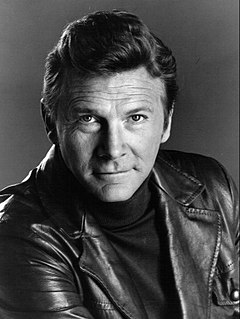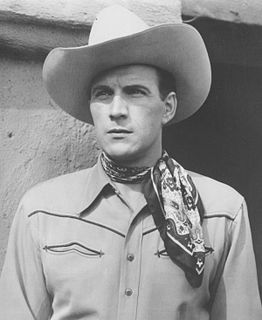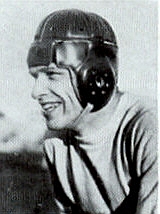
White Banners is a 1938 Warner Bros. drama film directed by Edmund Goulding and starring Claude Rains, Fay Bainter, Jackie Cooper, Bonita Granville, Henry O'Neill, and Kay Johnson.
The New York Yankees were a short-lived professional American football team from 1926 to 1929. The team was a member of the first American Football League in 1926, and later the National Football League from 1927 to 1929. They played their home games at Yankee Stadium. The team featured Red Grange at halfback.

Harold Edward "Red" Grange, nicknamed "the Galloping Ghost" and "the Wheaton Iceman", was an American football halfback for the University of Illinois, the Chicago Bears, and the short-lived New York Yankees. His signing with the Bears helped legitimize the National Football League (NFL).

Steve Forrest was an American actor who was well known for his role as Lt. Hondo Harrelson in the hit television series S.W.A.T. which was broadcast on ABC from 1975 to 1976. He was also known for his performance in Mommie Dearest (1981).

Tom Tyler was an American actor known for his leading roles in low-budget Western films in the silent and sound eras, and for his portrayal of superhero Captain Marvel in the 1941 serial film The Adventures of Captain Marvel. Tyler also played Kharis in 1940's The Mummy's Hand, a popular Universal Studios monster film.

Charles Stanton Ogle was an American stage and silent-film actor. He was the first actor to portray Frankenstein's monster in a motion picture in 1910 and played Long John Silver in Treasure Island in 1920.

Merton of the Movies is a 1924 American comedy film directed by James Cruze, written by Walter Woods, and starring Glenn Hunter and Viola Dana. It is based on the George S. Kaufman and Marc Connelly 1922 play of the same name, which in turn was based on Harry Leon Wilson's novel, also titled Merton of the Movies.

Film Booking Offices of America (FBO), also known as FBO Pictures Corporation, was an American film studio of the silent era, a producer and distributor of mostly low-budget films. It was founded in 1920 as Robertson–Cole (U.S.), the American division of a British import–export company formed by the English-born Harry F. Robertson. Robertson-Cole bought the Hallmark Exchanges from Frank G. Hall in 1920. Exhibitors-Mutual/Hallmark had distributed Robertson-Cole product, and acquiring the exchanges gave them the right to distribute their own films plus Hall's product, with the exception of Charlie Chaplin reissues which he had the rights to.
The 1925 Chicago Bears season was their sixth regular season completed in the National Football League. The team was unable to improve on their 6–1–4 record from 1924 and finished with a 9–5–3 record under head coach George Halas earning them a seventh-place finish in the team standings, their worst showing to that date. However, the 1925 Bears were the most notable team in the young NFL's history to that point all because of the addition of college players, including Red Grange.

Pigskin Parade is a 1936 American musical comedy film which tells the story of husband-and-wife college football coaches who convince a backwoods player to play for their team so they can go to the big game. It was written by William M. Conselman, Mary Kelly, Nat Perrin, Arthur Sheekman, Harry Tugend and Jack Yellen, and was directed by David Butler.
The first American Football League (AFL), sometimes called AFL I, AFLG, or the Grange League, was a professional American football league that operated in 1926. It was the first major competitor to the National Football League (NFL). Founded by Charles "C.C." Pyle, (1882–1939), and General Charles X. Zimmerman, (1865–1926), as vice president and starring Hall of Fame halfback Harold Edward "Red" Grange, (1903–1991), the short-lived league with nine teams competed against the more established – then six-year-old – NFL, both for players and for fans. While Pyle's and Grange's New York Yankees team and the already established Philadelphia Quakers became reliable draws, the lack of star power and the uncertain financial conditions of the other seven teams led to the league's dissolution after one season.

George Schly "Wildcat" Wilson was an American football player. After earning All-American honors in 1925 as a halfback for the University of Washington, he played professionally, including three seasons in the National Football League (NFL). Listed at 5 feet 10+1⁄2 inches (1.791 m) and 185 pounds (84 kg), he was inducted to the College Football Hall of Fame in 1951.
The 1926 AFL season is the only season of the first American Football League. It started with nine teams, with the initial game of the season being played in front of 22,000 fans in Cleveland, Ohio, but by the end of the season, only four teams were still in existence: three teams owned or subsidized by league founder C. C. Pyle and star Red Grange and league champion Philadelphia Quakers. The initial lineup of teams included the traveling Wildcats and a charter member of the National Football League, the Rock Island Independents, which became a second traveling team after having poor attendance in its first three games.
The Los Angeles Wildcats was a traveling team of the first American Football League that was not based in its nominal home city but in Chicago, Illinois. Coached by Jim Clark, the team was designed to be a showcase for University of Washington star back George “Wildcat” Wilson. Compared to most traveling teams in professional football, the Wildcats were successful, compiling a 6–6–2 record in the only season of the team's – and the league's – existence.
The Chicago Bulls were a professional American football team that competed in the first American Football League in 1926. Owned by Joey Sternaman, the Bulls also had AFL founders C. C. Pyle and Red Grange as shareholders. Joey Sternaman was also the coach and blocking back for the Bulls throughout their brief existence.
The Tampa Cardinals were a barnstorming football team, that played pick-up games, led by future Pro Football Hall of Famer, Jim Thorpe in 1926. During the time, the team was also billed as the St. Petersburg Cardinals and as Lena Vistas. The team was originally organized to play a New Year's Day exhibition against the Chicago Bears of the National Football League in what would be Tampa’s first professional football game. However, the team would later pick up four other games while in Florida. The team has also been referred to as Thorpe's Cardinals.
The 1926 College Football All-Southern Team consists of American football players selected to the College Football All-Southern Teams selected by various organizations for the 1926 Southern Conference football season. Alabama won the SoCon and national championship.

So This Is College is a 1929 American pre-Code comedy film directed by Sam Wood, written by Al Boasberg, Delmer Daves and Joseph Farnham, and starring Elliott Nugent, Robert Montgomery in his film debut, Cliff Edwards, Sally Starr and Phyllis Crane. It was released on November 8, 1929, by Metro-Goldwyn-Mayer.
A Racing Romeo is a 1927 American comedy film directed by Sam Wood and written by Byron Morgan. The film stars Red Grange, Jobyna Ralston, Trixie Friganza, Walter Hiers, Ben Hendricks Jr. and Warren Rogers. The film was released on September 1, 1927, by Film Booking Offices of America.










